膀胱压的测量
- 格式:ppt
- 大小:573.50 KB
- 文档页数:18

膀胱压测量操作流程及评分标准英文回答:Bladder Pressure Measurement Procedure.Materials:Urodynamic pressure transducer.Filling syringe.Filling fluid (e.g., sterile saline)。
Catheter.Procedure:1. Patient preparation:Void bladder to empty before the procedure.Position the patient supine with legs slightly abducted.Cleanse the external genitalia with antiseptic solution.2. Catheter insertion:Insert a sterile catheter into the bladder under sterile conditions.Ensure that the catheter tip is in the bladder by visual confirmation or aspiration of urine.3. Pressure transducer connection:Connect the pressure transducer to the catheter.Calibrate the transducer according to the manufacturer's instructions.4. Filling the bladder:Start filling the bladder with filling fluid at a rate of approximately 50-100 mL/min.Continue filling until the patient experiences a strong desire to void.5. Pressure measurement:Monitor the bladder pressure throughout thefilling process.Record the following pressure values:Pdet (detrusor pressure): The pressure generated by the detrusor muscle during bladder contraction.Pves (vesical pressure): The total pressure within the bladder, including Pdet and intra-abdominal pressure.Pabd (abdominal pressure): The pressure exerted by the abdominal muscles.6. Voiding:After reaching a maximum bladder capacity, allow the patient to void naturally.Record the post-void residual volume (PVR) if desired.Grading System.Detrusor Contractility:Normal: Strong detrusor contractions with Pdet >20 cmH2O.Hypocontractile: Weak detrusor contractions with Pdet <10 cmH2O.Acontractile: No detrusor contractions with Pdet = 0cmH2O.Compliance:Normal: Bladder expands easily with minimal increase in pressure.Decreased: Bladder expands with difficulty with a marked increase in pressure.Increased: Bladder expands excessively with a minimal increase in pressure.Sensation:Normal: The patient experiences a desire to void when Pves is <20 cmH2O.Hyposensitive: The patient experiences a desire to void only at high Pves (>40 cmH2O).Hypersensitive: The patient experiences a desire tovoid at low Pves (<10 cmH2O).中文回答:膀胱压测量操作流程。
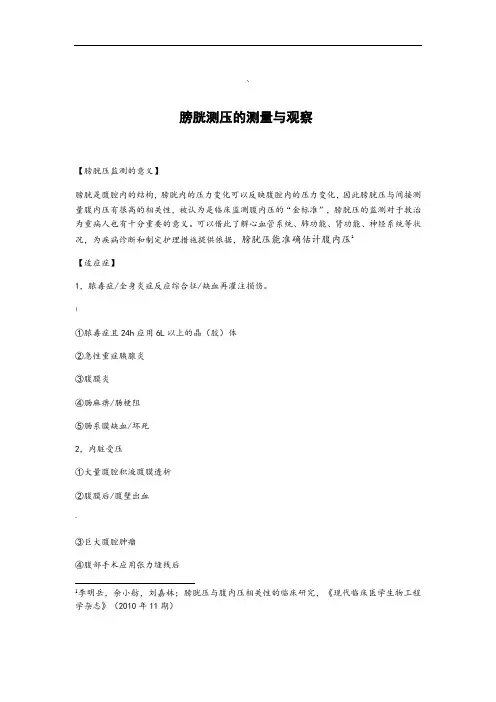
~膀胱测压的测量与观察【膀胱压监测的意义】膀胱是腹腔内的结构,膀胱内的压力变化可以反映腹腔内的压力变化,因此膀胱压与间接测量腹内压有很高的相关性,被认为是临床监测腹内压的“金标准”,膀胱压的监测对于救治为重病人也有十分重要的意义。
可以借此了解心血管系统、肺功能、肾功能、神经系统等状况,为疾病诊断和制定护理措施提供依据,膀胱压能准确估计腹内压1【适应症】1,脓毒症/全身炎症反应综合征/缺血再灌注损伤。
{①脓毒症且24h应用6L以上的晶(胶)体②急性重症胰腺炎③腹膜炎④肠麻痹/肠梗阻⑤肠系膜缺血/坏死2,内脏受压①大量腹腔积液腹膜透析②腹膜后/腹壁出血^③巨大腹腔肿瘤④腹部手术应用张力缝线后1李明岳,余小舫,刘嘉林;膀胱压与腹内压相关性的临床研究,《现代临床医学生物工程学杂志》(2010年11期)⑤腹裂脐膨出3,外科手术4,严重创伤(包括大面积烧伤)【禁忌症】①膀胱损伤②神经性膀胱③膀胱挛缩④尿道狭窄/断裂【测量方法】(1)…(2)有创测量:①腹腔穿刺置管②经股静脉置管侧压(3)无创测量:①胃内插如鼻饲管②直肠插管③置入导尿管(最常用)(3)置入导尿管监测方法:1.评估患者病情、意识、临床床表现、手术、腹部情况、尿管固定情况、机械通气参数和应用血管活性药物等。
2. 用物:标尺、%NS 100ml、膀胱冲洗器(本科室用输液器)2、选择测压部位测量方法:1)患者取仰卧位,放置Foley导尿,排空膀胱。
2)连接冲洗装置:一次性使用输液器连接%NS 100ml ,消毒导尿管,将输液器针头插入导尿管中、3)夹紧引流管,开放冲洗管,向尿管输入%NS 50——100ml4)夹紧冲洗管标尺零点位置对准耻合联合,夹紧冲洗管,分离引流管,膀胱冲洗器与标尺平衡,打放引流管,此时引流管液面下降,当液面达到一定水平不再下降时,患者呼气末时液平面在量尺的读数即为膀胱压。
1.5)、在护理记录单上记录测压数值2.【腹内压分级】1.腹内压可分4级。
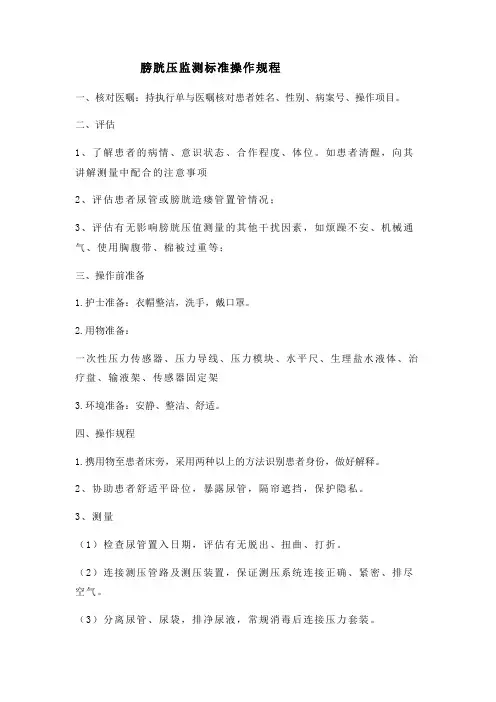
膀胱压监测标准操作规程一、核对医嘱:持执行单与医嘱核对患者姓名、性别、病案号、操作项目。
二、评估1、了解患者的病情、意识状态、合作程度、体位。
如患者清醒,向其讲解测量中配合的注意事项2、评估患者尿管或膀胱造瘘管置管情况;3、评估有无影响膀胱压值测量的其他干扰因素,如烦躁不安、机械通气、使用胸腹带、棉被过重等;三、操作前准备1.护士准备:衣帽整洁,洗手,戴口罩。
2.用物准备:一次性压力传感器、压力导线、压力模块、水平尺、生理盐水液体、治疗盘、输液架、传感器固定架3.环境准备:安静、整洁、舒适。
四、操作规程1.携用物至患者床旁,采用两种以上的方法识别患者身份,做好解释。
2、协助患者舒适平卧位,暴露尿管,隔帘遮挡,保护隐私。
3、测量(1)检查尿管置入日期,评估有无脱出、扭曲、打折。
(2)连接测压管路及测压装置,保证测压系统连接正确、紧密、排尽空气。
(3)分离尿管、尿袋,排净尿液,常规消毒后连接压力套装。
(4)夹闭尿管,向膀胱内匀速冲入37-40℃ 0.9%氯化钠25ml。
(5)使用水平尺校准压力换能器置于腋中线髂骨嵴水平.(6)按监护仪的调零钮,校对零点,监护仪自动调定零后,使测压管与尿管相通,正确测压。
测压后关闭测压管路,使尿管与尿袋相通。
4、整理(1)整理床单位(2)协助患者取舒适体位(3)按医疗垃圾分类原则处理用物(4)洗手5、处理医嘱,记录6、指导要点(1)告知患者情绪稳定,腹肌放松,不要收缩(2)告知患者测量期间避免咳嗽咳痰、屏气等,以免影响测量结果二、膀胱压监测标准操作流程注意事项:一、膀胱压监测的标准方法为:完全平卧位,腹肌无收缩情况下,以腋中线为零点,膀胱内注入0.9%氯化钠25m l,在呼气末读数,并以m m Hg为单位。
二、膀胱压测量影响因素(一)患者本身因素:1、腹内压受多种因素影响,在腹腔施加任何外力都会使腹内压增高,影响疾病的判断。
2、患者应处于安静状态,必要时予以镇静治疗。

膀胱压监测的标准操作流程下载温馨提示:该文档是我店铺精心编制而成,希望大家下载以后,能够帮助大家解决实际的问题。
文档下载后可定制随意修改,请根据实际需要进行相应的调整和使用,谢谢!并且,本店铺为大家提供各种各样类型的实用资料,如教育随笔、日记赏析、句子摘抄、古诗大全、经典美文、话题作文、工作总结、词语解析、文案摘录、其他资料等等,如想了解不同资料格式和写法,敬请关注!Download tips: This document is carefully compiled by theeditor. I hope that after you download them,they can help yousolve practical problems. The document can be customized andmodified after downloading,please adjust and use it according toactual needs, thank you!In addition, our shop provides you with various types ofpractical materials,such as educational essays, diaryappreciation,sentence excerpts,ancient poems,classic articles,topic composition,work summary,word parsing,copy excerpts,other materials and so on,want to know different data formats andwriting methods,please pay attention!1. 准备工作:患者准备:向患者解释操作目的和过程,取得患者的配合。

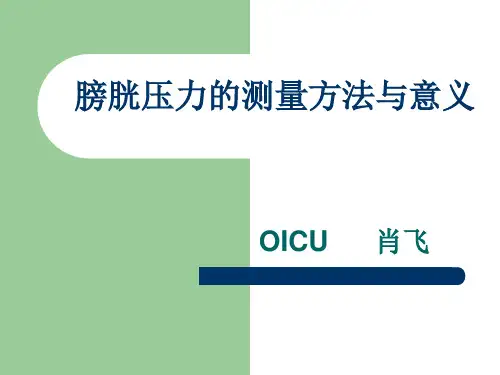
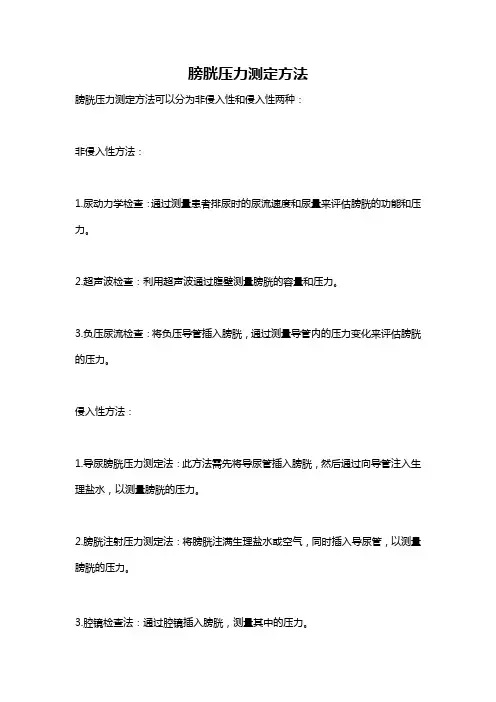
膀胱压力测定方法
膀胱压力测定方法可以分为非侵入性和侵入性两种:
非侵入性方法:
1.尿动力学检查:通过测量患者排尿时的尿流速度和尿量来评估膀胱的功能和压力。
2.超声波检查:利用超声波通过腹壁测量膀胱的容量和压力。
3.负压尿流检查:将负压导管插入膀胱,通过测量导管内的压力变化来评估膀胱的压力。
侵入性方法:
1.导尿膀胱压力测定法:此方法需先将导尿管插入膀胱,然后通过向导管注入生理盐水,以测量膀胱的压力。
2.膀胱注射压力测定法:将膀胱注满生理盐水或空气,同时插入导尿管,以测量膀胱的压力。
3.腔镜检查法:通过腔镜插入膀胱,测量其中的压力。


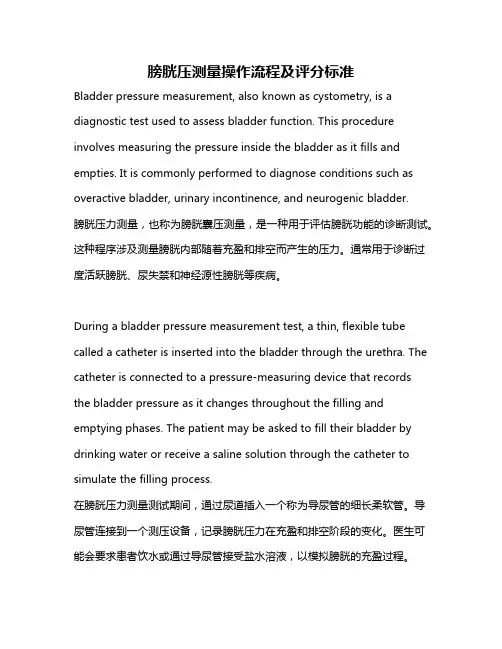
膀胱压测量操作流程及评分标准Bladder pressure measurement, also known as cystometry, is a diagnostic test used to assess bladder function. This procedure involves measuring the pressure inside the bladder as it fills and empties. It is commonly performed to diagnose conditions such as overactive bladder, urinary incontinence, and neurogenic bladder.膀胱压力测量,也称为膀胱囊压测量,是一种用于评估膀胱功能的诊断测试。
这种程序涉及测量膀胱内部随着充盈和排空而产生的压力。
通常用于诊断过度活跃膀胱、尿失禁和神经源性膀胱等疾病。
During a bladder pressure measurement test, a thin, flexible tube called a catheter is inserted into the bladder through the urethra. The catheter is connected to a pressure-measuring device that recordsthe bladder pressure as it changes throughout the filling and emptying phases. The patient may be asked to fill their bladder by drinking water or receive a saline solution through the catheter to simulate the filling process.在膀胱压力测量测试期间,通过尿道插入一个称为导尿管的细长柔软管。

膀胱压测定操作流程
1.评估患者导尿管通畅,膀胱排空
2.遵医嘱行腹内压监测
3.患者准备:心电监护,解释,烦躁者适当约束必要时镇静,患者取
平卧位,注意保护隐私
4.用物准备:治疗盘、延长管,25ml生理盐水、标尺、三通一个,无菌
剪
5.连接管路:消毒引流管,用无菌剪剪开,“一字"型连接三通,三通
侧口连接延长管接注射器.
6.排空膀胱后旋转三通开关使导尿管端与延长管相通,管道内注入
20ml无菌生理盐水,作为腹内压的传导介质,以患者腋中线为零点测量病人的膀胱内压
7.脱开注射器,使延长管于大气相通,观察水柱波动情况
8.注意要点:严格无菌操作,神智清醒患者给予心理护理,与患者沟
通取得配合,测压完毕及时去除连接装置,做好终末端无菌保护。
9.获取准确读数操作结束后转回三通,使导尿管和引流管相通保
持引流通畅,整理用物,置于患者正确卧位。
10.做好记录,汇报医生。